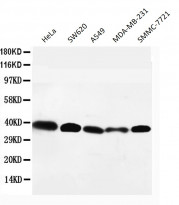ARG58807
anti-GPR2 / CCR10 antibody
anti-GPR2 / CCR10 antibody for Western blot and Human
Overview
| Product Description | Rabbit Polyclonal antibody recognizes GPR2 / CCR10 |
|---|---|
| Tested Reactivity | Hu |
| Predict Reactivity | Ms, Rat, Hm |
| Tested Application | WB |
| Host | Rabbit |
| Clonality | Polyclonal |
| Isotype | IgG |
| Target Name | GPR2 / CCR10 |
| Antigen Species | Human |
| Immunogen | Synthetic peptide corresponding to aa. 312-327 of Human GPR2 / CCR10 (FLGLRFRQDLRRLLRG). |
| Conjugation | Un-conjugated |
| Alternate Names | GPR2; CC-CKR-10; CCR-10; C-C CKR-10; G-protein coupled receptor 2; C-C chemokine receptor type 10 |
Application Instructions
| Application Suggestion |
|
||||
|---|---|---|---|---|---|
| Application Note | * The dilutions indicate recommended starting dilutions and the optimal dilutions or concentrations should be determined by the scientist. |
Properties
| Form | Liquid |
|---|---|
| Purification | Affinity purification with immunogen. |
| Buffer | 0.9% NaCl, 0.2% Na2HPO4, 0.05% Thimerosal, 0.05% Sodium azide and 5% BSA. |
| Preservative | 0.05% Thimerosal and 0.05% Sodium azide |
| Stabilizer | 5% BSA |
| Concentration | 0.5 mg/ml |
| Storage Instruction | For continuous use, store undiluted antibody at 2-8°C for up to a week. For long-term storage, aliquot and store at -20°C or below. Storage in frost free freezers is not recommended. Avoid repeated freeze/thaw cycles. Suggest spin the vial prior to opening. The antibody solution should be gently mixed before use. |
| Note | For laboratory research only, not for drug, diagnostic or other use. |
Bioinformation
| Database Links | |
|---|---|
| Gene Symbol | CCR10 |
| Gene Full Name | chemokine (C-C motif) receptor 10 |
| Background | Chemokines are a group of small (approximately 8 to 14 kD), mostly basic, structurally related molecules that regulate cell trafficking of various types of leukocytes through interactions with a subset of 7-transmembrane, G protein-coupled receptors. Chemokines also play fundamental roles in the development, homeostasis, and function of the immune system, and they have effects on cells of the central nervous system as well as on endothelial cells involved in angiogenesis or angiostasis. Chemokines are divided into 2 major subfamilies, CXC and CC, based on the arrangement of the first 2 of the 4 conserved cysteine residues; the 2 cysteines are separated by a single amino acid in CXC chemokines and are adjacent in CC chemokines. CCR10 is the receptor for CCL27 (SCYA27; MIM 604833); CCR10-CCL27 interactions are involved in T cell-mediated skin inflammation (Homey et al., 2002 [PubMed 11821900]).[supplied by OMIM, Mar 2008] |
| Function | Receptor for chemokines SCYA27 and SCYA28. Subsequently transduces a signal by increasing the intracellular calcium ions level and stimulates chemotaxis in a pre-B cell line. [UniProt] |
| Cellular Localization | Cell membrane; Multi-pass membrane protein. [UniProt] |
| Calculated MW | 38 kDa |
Images (1) Click the Picture to Zoom In






